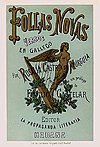| Rexurdimento | |||
 Follas Novas. |
"Rexurdimento" (revival) is the name given to the nineteenth century in the history of Galician literature and implies that the recovery was not only literary but also cultural, political and historical. After the French invasion (1809) and the conflicts between the absolutists and liberals the first texts were written in Galician, printed on loose sheets or in newspapers for propaganda purposes. Some called the peasants to defend their country and others defended liberal ideas. Throughout the century, after the end of the absolutism and the start of the constitutional monarchy, various Galician movements grew up based on the defence of the individuality and personality of Galicia. The first, in the forties, was "Provincialism" which proclaimed the social abandonment of the country and attempted to achieve social esteem for its art, customs and history. These movements were left outside political circles after their support of the failure of the Solis military uprising -the shooting of the "Carral Martyrs"- and they took refuge in the world of culture and literature. The second 'Galicianist' generation, "Regionalism", brought together culture and politics, with the language being their main concern. A step along the way towards linguistic and literary strengthening, were the first "Floral Games" held in A Coruña in 1861. The prize-winning compositions, with samples of contemporary poetry, appeared a year later in the Album de la Caridad, which was the first anthology of the Galician "Rexurdimento". The publication in 1863 of the Cantares Gallegos, entirely written in Galician by our superb poetess, Rosalía de Castro, marked the beginning of the "Rexurdimiento" in full. The quality of the works by Rosalia de Castro crossed the frontiers of Galicia and became part of universal literature. Her poetry was the object of many studies and translations into other languages. 1880 was a year of many publications. Compositions by the most famous authors of the times appeared: Follas Novas by Rosalia de Castro, Aires da miña terra by Curros Enriquez, Saudades Gallegas by Lamas de Carvajal. And six years later, the Queixumes dos pinos by Eduardo Pondal was published. | ||
 Curros Enríquez. |
Curros Enríquez was one of the favourite authors of his time. His poetry reported the social injustices (emigration, opression ...) and defenced progressive ideas. Curros set up a tradition of combative poetry carried on later by a number of writers (Cabanillas, Celso Emilio...). Pondal, author of the Galician anthem, looked for the pre-historic roots of his people,
highlighting its cultivated side in order to exalt it from its individuality.
Pondal aimed to fix Galician as a cultivated and literary language. The "Rexurdimento" authors were not aware of the rich tradition of medieval Galician lyric poetry. They wrote under the conviction that they were the first to use the language for literary purposes. They therefore had no idiomatic rules to follow and had to base their writing on oral usage. The limits to our literature stretched slowly beyond lyrical poetry to narrative, essays and didactic prose. The consolidation of Galician prose did not take place until the twentieth century, but by the end of the nineteenth there were already important precedents: Maxina ou a filla espúrea (1880) by Marcial Valladares, the first contemporary Galician novel. A work which reached great popularity among the popular classes was O Catecismo do labrego by Lamas Carvajal, and A Tecedeira de Bonaval, O Castelo de Pambre and O niño de Pombas made their author, Antonio Lopez Ferreiro, the best prose-writer of his times. Playwriting was less popular. After the publication of A Casamenteira in 1812 no theatrical works were published until the eighties. In the last decades of the nineteenth century the first grammars and dictionaries of the Galician language appeared and these were essential for the standardisation process: Compendio de gramatica gallega-castellana by Francisco Mirás (1864), and the Gramatica Gallega by Saco and Arce which was a serious study of the Galician language. The presence of Galician in the press brought great prestige to the language. In 1876 Valentin Lamas Carvajal promoted the publication of the pioneer of newspapers printed completely in Galician, O Tio Marcos da Portela. The success of this newspaper, and its clear anti-caciquism, was spectacular. Between 1886 and 1888 the press in Galicia became consolidated with the appearance of new monolingual initiatives: O Galiciano in Pontevedra, A Monteira in Lugo and As Burgas in Ourense. One of the last manifestations of the "Rexurdimento" in the twentieth century was the constitution in 1905 of the "Real Academia Galega" (the Royal Academy of the Galician Language). | ||
Back | |||